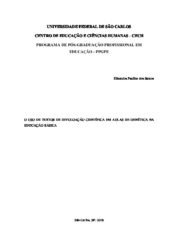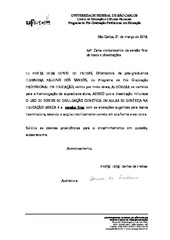| dc.contributor.author | Santos, Elizandra Paulino dos | |
| dc.date.accessioned | 2018-05-10T19:56:34Z | |
| dc.date.available | 2018-05-10T19:56:34Z | |
| dc.date.issued | 2018-02-20 | |
| dc.identifier.citation | SANTOS, Elizandra Paulino dos. O uso de textos de divulgação científica em aulas de genética na educação básica. 2018. Dissertação (Mestrado em Educação) – Universidade Federal de São Carlos, São Carlos, 2018. Disponível em: https://repositorio.ufscar.br/handle/ufscar/9970. | * |
| dc.identifier.uri | https://repositorio.ufscar.br/handle/ufscar/9970 | |
| dc.description.abstract | The questioning about the fundamental role of the School in contemporary society is recurrent by the professionals of Education faced with the difficulties of constructing models and teaching practices that cover the real needs of the students. Considering that the purpose of the School is to form critical and reflective citizens able to play their roles in society consciously, full mastery of reading ability is an essential condition. Therefore, we use in this work texts of scientific dissemination (SDT) as didactic resource due to its great pedagogical potential. The research had as objectives: to elaborate and to apply a didactic sequence with theoretical contents of genetics in a STS perspective; identify the STS approach of the study; to evaluate how the reading of SDT contributed to the development of the reading ability; to evaluate if the use of SDT as didactic resource contributed to the consolidation of the learning of concepts of Genetics. As an instrument of data collection, a questionnaire of open answers and questions of interpretation of texts were used. The didactic sequence was elaborated with texts extracted from the Magazines Ciência Hoje and Pesquisa FAPESP. Its application was made in 2016, in a class of the 2nd year of the high school of a public school in the interior of São Paulo. The analysis of the answers given by the students to the questions of interpretation of the SDT revealed difficulties in making inferences and in recognizing the overall aspect of the texts. Regarding the levels in the cognitive domain of the revised Bloom taxonomy, it was expected that students in the second year of high school were able to perform activities belonging to the categories remember, understand, analyze and evaluate, but the results indicate that the correct answers to questions are when they require only the recognition of explicit information (category remember). As for learning in genetics, we perceive a better mastery of concepts such as gene, genome, chromosomal mutation, DNA and transgenics. The small progress in learning conquered leads us to believe that SDT is an important instrument for the integration between Science, Technology and Society (STS) and that its use in Science classes will allow an introduction of a STS education system. | eng |
| dc.description.sponsorship | Não recebi financiamento | por |
| dc.language.iso | por | por |
| dc.publisher | Universidade Federal de São Carlos | por |
| dc.rights.uri | Acesso aberto | por |
| dc.subject | Texto de divulgação científica | por |
| dc.subject | Ensino de genética | por |
| dc.subject | Teaching of Genetics | eng |
| dc.title | O uso de textos de divulgação científica em aulas de genética na educação básica | por |
| dc.type | Dissertação | por |
| dc.contributor.advisor1 | Freitas, Denise de | |
| dc.contributor.advisor1Lattes | http://lattes.cnpq.br/3330976062026878 | por |
| dc.description.resumo | O questionamento sobre o papel fundamental da Escola na sociedade contemporânea é recorrente pelos profissionais da Educação diante das dificuldades de se construir modelos e práticas de ensino que abranjam as necessidades reais dos alunos. Considerando que a Escola tem por finalidade formar cidadãos crítico-reflexivos aptos a desempenhar seus papéis na sociedade de forma consciente, o pleno domínio da capacidade leitora é condição essencial. Por isso, utilizamos nesse trabalho textos de divulgação científica (TDC) como recurso didático devido ao seu grande potencial pedagógico. A pesquisa teve por objetivos: elaborar e aplicar uma sequência didática com conteúdos teóricos de genética numa perspectiva CTS; identificar a abordagem CTS do estudo; avaliar como a leitura de TDC contribuiu para o desenvolvimento da habilidade leitora; avaliar se o uso de TDC como recurso didático contribuiu para a consolidação da aprendizagem de conceitos de Genética. Como instrumento de coleta de dados foi utilizado questionário de respostas abertas e questões de interpretação de textos. A sequência didática foi elaborada com textos extraídos das Revistas Ciência Hoje e Pesquisa FAPESP. Sua aplicação foi realizada em 2016, numa turma do 2º ano do EM de uma escola pública do interior de São Paulo. A análise das respostas dadas pelos alunos às questões de interpretação dos TDC nos revelou suas dificuldades em realizar inferências e em reconhecer o aspecto global dos textos. Em relação aos níveis no domínio cognitivo da taxonomia de Bloom revisada, esperava-se que os alunos do 2º ano do EM fossem capazes de realizar atividades pertencentes as categorias lembrar, entender, analisar e avaliar, porém os resultados indicam que os acertos às questões são maiores quando as mesmas requerem apenas o reconhecimento de informações explícitas (categoria lembrar). Quanto à aprendizagem em genética, percebemos um melhor domínio de conceitos como gene, genoma, mutação cromossômica, DNA e transgênicos. O pequeno avanço na aprendizagem conquistado nos leva a crer que o TDC seja um instrumento importante para a integração entre a ciência, a tecnologia e a sociedade (CTS) e que seu uso em aulas de Ciências permitirá uma introdução de uma abordagem CTS nos sistemas de ensino. | por |
| dc.publisher.initials | UFSCar | por |
| dc.publisher.program | Programa de Pós-Graduação Profissional em Educação - PPGPE | por |
| dc.subject.cnpq | CIENCIAS HUMANAS::EDUCACAO::ENSINO-APRENDIZAGEM | por |
| dc.ufscar.embargo | Online | por |
| dc.publisher.address | Câmpus São Carlos | por |
| dc.contributor.authorlattes | http://lattes.cnpq.br/4447289423954663 | por |

